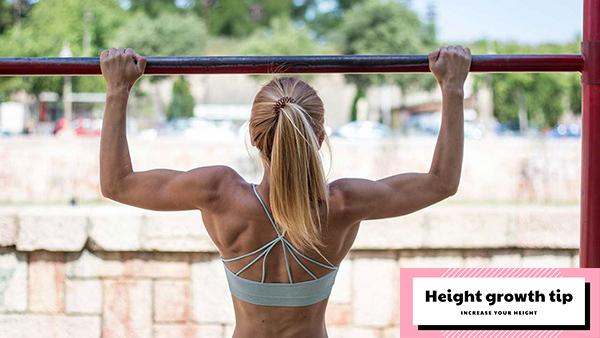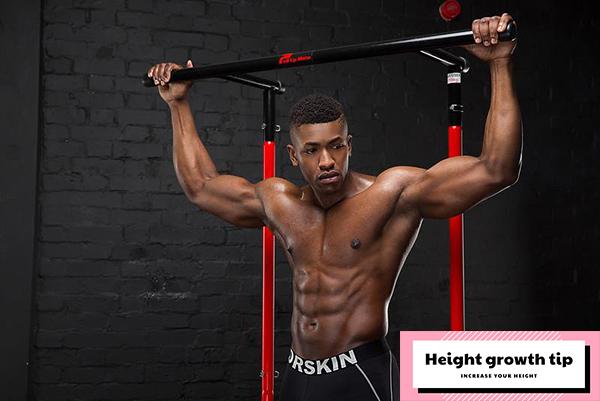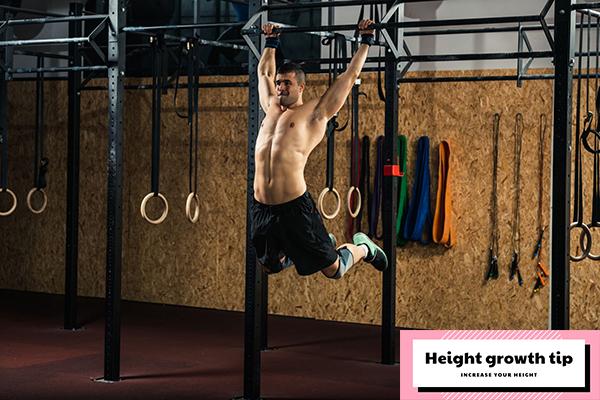Many of us have tried all sorts of diets and exercises in the hope of gaining a few extra inches in height. From specialized regimens to quirky stretching routines, we’ve explored every avenue imaginable in pursuit of this elusive goal.
But amidst this labyrinth of height-enhancement techniques, an unexpected contender has emerged: the humble pull-up. The idea that such a basic exercise could hold the key to unlocking our growth potential might initially sound too good to be true. Yet, as discussions around this topic gain steam and new research surfaces, it’s hard to ignore the growing whispers of a connection between pull-ups and the human growth hormone (HGH) – the substance that drives our vertical growth during adolescence.
As we dive deeper into this exploration, it becomes clear that the pull-up’s impact goes beyond just building muscle. Could it be that this fundamental exercise harbors the power to tap into our genetic blueprint, coaxing our bodies to reach for greater heights? Join me as we venture into the realms of science and speculation, aiming to decode the enigma surrounding the potential influence of pull-ups on our stature.
Why Pull-Ups Can Enhance the Appearance of Height
While pull-ups won’t actually make you taller, they offer a host of benefits that can create the appearance of increased height and a more imposing presence. The key lies in how pull-ups impact your posture and physique.
Pull-ups primarily target the muscles in your upper body and core. As these muscles grow stronger, your posture naturally improves – you’ll stand taller and carry yourself with greater confidence and poise. This upright, commanding stance gives the visual impression of added height.
Beyond just posture, pull-ups also stimulate the production of human growth hormone (HGH) and testosterone. HGH helps maintain muscle mass and facilitate growth, while testosterone supports the protein synthesis essential for muscle development. Even if you’ve reached your full genetic height, these hormonal benefits can help you build a more robust, well-proportioned physique.
The pull-up motion itself also has a sculpting effect that accentuates the perception of height. The upward pull elongates your chest and broadens your shoulders, creating a more pronounced V-shape. Pair this physique with smart clothing choices, and you’ll appear taller and more imposing.
Pull-ups also strengthen the deep core and back muscles that are crucial for upper body alignment and balance. By preventing slouching and discomfort, these muscles allow you to project an aura of confidence and poise – further enhancing the impression of increased stature.
So while pull-ups may not directly make you taller, the postural improvements, muscle development, and overall physique enhancement they provide can absolutely give you a leg up in appearing larger than life.

Unlocking the Full Potential of Pull-Ups: A Comprehensive Guide
Mastering the pull-up can be a game-changer in your fitness journey. To harness the incredible benefits of this exercise, it’s essential to approach it with precision and finesse. Let’s dive into a comprehensive guide to ensure you perform pull-ups correctly and maximize their impact.
- Choose Your Grip: Start by selecting the grip that feels most comfortable. You can face your palms forward or towards you, but be mindful not to grip the bar with excessive force, especially using your thumbs.
- Prioritize Posture: Maintain a confident posture, with a slightly protruded chest and impeccable alignment. Throughout the exercise, ensure your body remains upright, exuding grace and poise.
- Optimal Bar Height: Position the bar at a height that allows you to jump up and grip it while your feet dangle freely. This setup will enable a smooth start to your pull-up motion.
- The Ascent: Initiate the pull-up by bending your elbows and pulling your body upwards. The goal is to gracefully clear your chin over the bar, maintaining control and strength throughout this phase.
- Embrace Balance: Achieving balance is crucial for a stable, vertical position during pull-ups. Cross your legs to minimize any swinging or erratic movements that might compromise your form.
- Pause at the Peak: After conquering the ascent, take a brief moment to pause at the zenith of the movement. This momentary pause adds an extra layer of control and finesse to your pull-up. Descend with grace and control.
- Continuous Flow: Don’t fully extend your arms at the bottom of the movement. Instead, initiate the next pull-up while maintaining a continuous flow. This strategy maximizes the effectiveness of the exercise.
By diligently following these steps, you’ll execute pull-ups with unparalleled precision, unlocking their full potential for your fitness goals. Always prioritize flawless form and technique to reap the most significant benefits from this exercise.
How Many Pull-Ups to Increase Height in One Week?
Engaging in hanging exercises, where you support your body weight using a bar, can encourage muscle stretching. However, expecting a noticeable increase in height within a single week is an unrealistic goal. Height growth is a gradual process that demands patience and dedication.
There is no magic number of pull-ups that can guarantee height gain, as the development of the muscles supporting your spine varies from person to person. For beginners, the best approach is to tune in to your body’s signals.
If performing a single pull-up is challenging, consider using a weight-assisted pull-up machine at the gym. This tool reduces the resistance you need to lift, making it a valuable resource for those new to the exercise.
Fitness experts often recommend setting a modest goal of achieving five pull-ups in the first week and gradually increasing the count each subsequent week. Start with two pull-up sessions per week and integrate other upper body exercises, such as weightlifting, to enhance your grip strength and overall muscle development.
Remember, the key to incorporating pull-ups into your fitness routine lies in consistency and gradual progression. Focus on understanding your body’s capabilities and steadily pushing your limits over time. By doing so, you’ll be on the path to achieving your fitness goals and maintaining a healthy lifestyle.

Exploring the Additional Advantages of Incorporating Pull-Ups into Your Fitness Routine:
Pull-ups are a gym-class staple, but did you know they offer a wealth of benefits beyond just building upper-body strength? Mastering this deceptively simple exercise can unlock a whole host of advantages that extend far beyond the physical.
Grip Strength to Grip Attention
One of the stand-out perks of pull-ups is the boost they provide to your grip strength. This newfound hand and forearm power serves you well in all kinds of activities, from rock climbing to martial arts. But the benefits don’t stop there – studies show a strong grip is also linked to better heart health. So those pull-ups aren’t just sculpting your arms, they’re supporting your cardiovascular wellbeing too.
Customizable Challenges
Pull-ups are wonderfully adaptable, making them suitable for fitness buffs of all levels. Even a few reps can deliver an intense challenge for beginners. But as your skills progress, the possibilities for cranking up the difficulty are endless – add extra sets, increase the reps, or get creative with straps and weights. The beauty is, you can keep these compound exercises fresh and exciting as you get stronger.
Cardio and Calorie Burn in One
When you engage in pull-ups, you’re working major and minor muscle groups simultaneously, driving up your heart rate and oxygen intake. This cardio boost, combined with the calorie-torching nature of the movement, makes pull-ups a powerful tool for both cardiovascular health and weight management. As you get leaner, the pull-ups themselves will become easier to execute, creating an upward spiral of fitness.
The Whole-Body Advantage
The benefits of pull-ups go way beyond just building muscle. Regular practice has been shown to lower blood pressure, reduce visceral fat, improve blood sugar control, and even enhance insulin sensitivity. Paired with a well-rounded exercise routine, pull-ups can significantly reduce your risk of conditions like type 2 diabetes, obesity, and heart disease.
Mental Muscle
While pull-ups excel at sculpting physical strength, they also deliver a boost to your mental wellbeing. The endorphin rush and mood-elevating effects of this strength training exercise can help alleviate anxiety, depression, and post-workout soreness. It’s a win-win for your body and your mind.
Convenience Supercharged
Perhaps best of all, pull-ups require minimal equipment – just a sturdy bar. This makes them the perfect exercise to integrate seamlessly into your routine, whether you’re at the gym, the park, or even in your own backyard. No bulky machines or complicated setups required, just pure, functional fitness at its finest.
So why not give your fitness routine a pull-up powered upgrade? With all these incredible benefits, it’s time to make this classic move a staple in your workout arsenal

In summary:
Pull-ups offer a wealth of benefits that go beyond just building upper body strength. Incorporating pull-ups into your fitness routine can have a profound impact on your skeletal health. The pulling motion helps elongate your bones and promotes the growth of important cartilage layers, which are crucial for continued development. Additionally, pull-ups take pressure off your bones and joints by partially supporting your body weight.
Beyond their skeletal benefits, pull-ups are also a fantastic full-body exercise that can significantly boost your overall strength and fitness. One particularly noteworthy advantage is their ability to improve your posture, which can even create the illusion of increased height. What makes pull-ups truly versatile is that they can be performed almost anywhere, making them a highly accessible and convenient exercise option.

